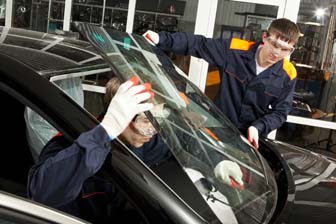Summary
Please enable javascript to play this video.
| Quick Facts: Automotive Body and Glass Repairers | |
|---|---|
|
$50,680 per year
$24.36 per hour |
|
| High school diploma or equivalent | |
| None | |
| See How to Become One | |
| 193,000 | |
| 2% (Slower than average) | |
| 3,500 | |
What Automotive Body and Glass Repairers Do
Automotive body and glass repairers restore, refinish, and replace vehicle bodies and frames, windshields, and window glass.
Work Environment
Automotive body repairers work indoors in body shops, which are often noisy. Shops are typically well ventilated, so that dust and paint fumes can be dispersed. Repairers sometimes work in awkward and cramped positions, and their work can be physically demanding.
Automotive glass installers and repairers often travel to the customer’s location to repair damaged windshields and window glass.
How to Become an Automotive Body or Glass Repairer
Most employers prefer to hire automotive body and glass repairers who have completed a training program in automotive body or glass repair. Still, many new automotive body and glass repairers begin work without previous training. Industry certification is becoming increasingly important.
Pay
The median annual wage for automotive body and related repairers was $51,680 in May 2024.
The median annual wage for automotive glass installers and repairers was $47,260 in May 2024.
Job Outlook
Overall employment of automotive body and glass repairers is projected to grow 2 percent from 2024 to 2034, slower than the average for all occupations.
Despite limited employment growth, about 16,000 openings for automotive body and glass repairers are projected each year, on average, over the decade. Most of those openings are expected to result from the need to replace workers who transfer to different occupations or exit the labor force, such as to retire.
State & Area Data
Explore resources for employment and wages by state and area for automotive body and glass repairers.
Similar Occupations
Compare the job duties, education, job growth, and pay of automotive body and glass repairers with similar occupations.
More Information, Including Links to O*NET
Learn more about automotive body and glass repairers by visiting additional resources, including O*NET, a source on key characteristics of workers and occupations.
 United States Department of Labor
United States Department of Labor









